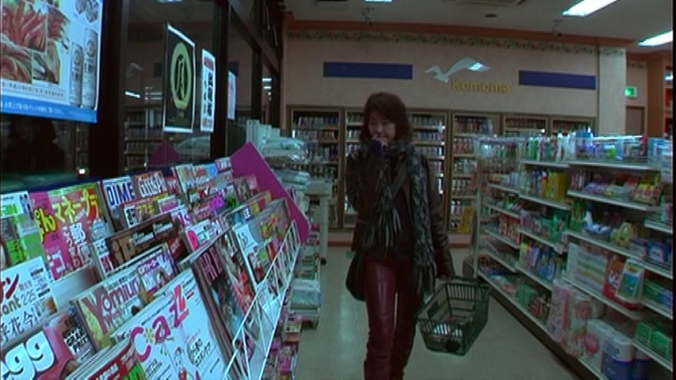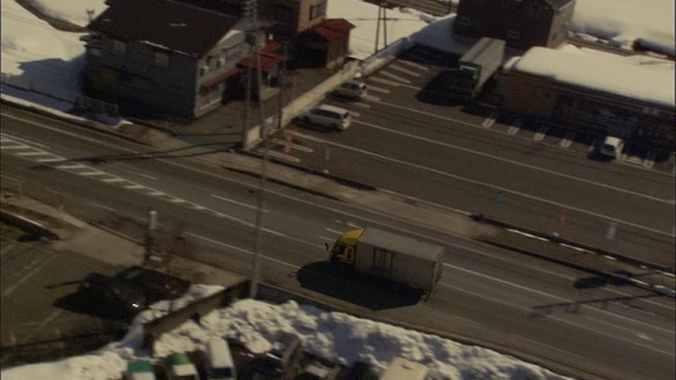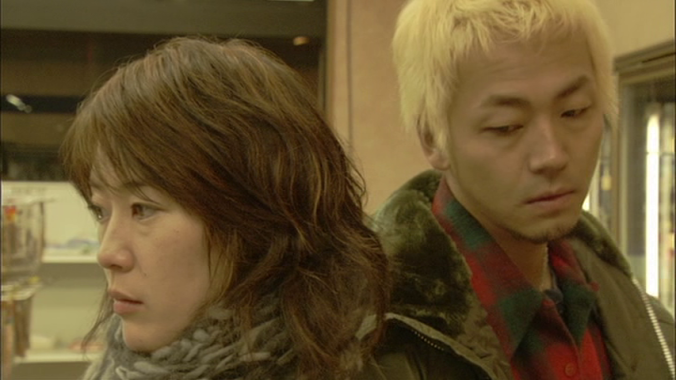As the new century developed, the isolation and loneliness of contemporary urban life became an increasingly visible topic in Japanese movies. Vibrator looks at that loneliness from the viewpoint of a woman (who does not use a vibrator at any time) now 31 and the essence of unattached.
We first meet Rei in a mini-mart, indistinguishable from any similar American store except for some signs and labels in Japanese, in one of the suburban areas of Tokyo. As she wanders around the store looking for booze, we hear a stream-of-consciousness dialogue in her head about the best wine to buy, the diet and fashion articles she writes for and reads in women’s magazines, and an unwillingness to go back to her apartment. When a young man with hair bleached almost yellow rather than blonde walks in, we see inter-cut titles of her deeper thoughts, hoping he will notice her, that he will touch her, even “love me, love me, love me.” The man takes his chips and soda back to his truck and she stands outside staring, hoping for a signal. At last he invites her in, they chat and share the chips, and she decides to go with him in his truck when he parks to wait for his morning delivery.
Before we know it, she has decided to ride with him and we have a road movie with almost no one other than the two people to be seen. Along the way there is sex as well – regular, oral, and even implausibly arranged anal – but it is not a variation of Woman with Red Hair, though most of Ryuichi Hiroki’s movies had been pinku films. Rie wants to be touched, but even more she wants to be touched emotionally. Most of the movie is simply conversation inside the cab of the truck.
Takatoshi talks about his past: school dropout, a brief time as a pimp, another brief period smuggling drugs for the yakuza, and work for a transport company before he could buy his own truck. He too is a freelance, a driver living on the road, so his cab is fitted out with a bunk as well. He says he has a wife and child back in Niigata across the mountains, from whence he has come and which the couple will eventually visit as he picks up miscellaneous loads for miscellaneous destinations. The truck is not a semi, for he has a permanently attached container, but otherwise the life is that of the American independent trucker, always on the road, living in his cab, with occasional rests at restaurants or a night in a motel to clean up. One of his most important pieces of equipment is his CB radio, which has not played much of a part in American movies since the Convoy/Smoky and the Bandit era of the seventies, but which is used just as in America, to keep other truckers aware of weather conditions, of road repairs, and of police checks for loads exceeding weight limits, and to provide a sense of community for men driving alone. Thus, it looks very much like an American movie. This is encouraged by a soundtrack of popular music in a mix of Japanese and English, some heard on the radio (Pat Boone’s “April Love” of all things) but mostly used as the soundtrack itself.
Eventually the conversation runs out and Rei realizes that he has not only invented most of his past but is now talking to her in just the same way he would talk to himself when alone and somehow the connection between them is broken. This is a Japanese movie, so there is no fight, no argument, just a long single take with both characters in the middle distance as she discusses the situation in a restaurant.
Rie ends up standing in the falling snow outside the same mini-mart as he pulls away and she goes back in to buy her booze, talking to herself as she had done at the beginning. Perhaps it was all a dream and, though he looks longingly at her as he pulls away, she had never actually worked up the nerve to walk over to the truck. Either way, nothing has been changed and her life of loneliness will continue.
Hiroki had been one of the pioneers in the use of the digital camera and in Vibrator he takes full advantage of the new technology to make a movie as sleek as any shot directly on film. Almost all of the scenes take place inside the truck cab, but most are shot from a number of different angles both inside and from outside while it is in motion and are as clear as any other scenes that might have been shot inside a studio. Never does the limited setting become visually boring. The truck travels on smaller roads to avoid toll booths and weight checks, so we see a Japan of suburbs, small highways, industrial parks, gas stations, parking lots, and snow as he crosses the mountains, neither lushly pastoral nor bleak, just ordinary.
Nao Omori as Takatoshi seems like a nice guy, more than a bit confused by Rei but glad for the company. Though he claims a checkered past, nothing about him seems wicked or manipulative or that he makes it a habit to pick up young women for a fling. Like Rei, he is another lonely person, without any roots in the contemporary society. Nevertheless, the movie is Rei’s story. This was part of a break-out year for Shinobu Terajima (daughter of Junko Fuji). She had worked mostly on stage and TV until now turned thirty she suddenly became a major film actress as well, leading to a career that would result in the most recent Kinuyo Tanaka Award, all of which started with Vibrator and Akame 48 Waterfalls released in the same year.
This was part of a break-out year for Shinobu Terajima (daughter of Junko Fuji). She had worked mostly on stage and TV until now turned thirty she suddenly became a major film actress as well, leading to a career that would result in the most recent Kinuyo Tanaka Award, all of which started with Vibrator and Akame 48 Waterfalls released in the same year.





I thought the entire truck episode was her ‘vibrator’ fantasy. Female sexual fantasies are apparently more complex than my fantasies. Regardless, I liked it and I thought your review was good.
LikeLike
Pingback: L’Amant (2004) | Japanonfilm
Pingback: Love on Sunday / Koi suru nichiyobi (2006) | Japanonfilm
Pingback: Million Yen Girl / Hyakuman-en to nigamushi onna (2008) | Japanonfilm